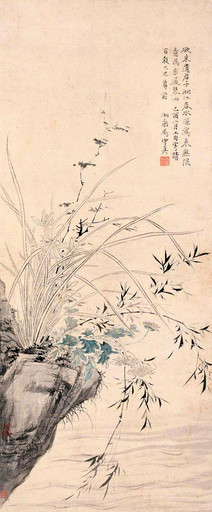Ma Xianglan’s world reflected in lan

A lan-bamboo-rock painting by Ma Xianglan
The works of ancient female Chinese painters are part of the Chinese history of art. Paintings by women were particularly popular in the Ming and Qing dynasties (1368-1912). These painters radiated unique charms with their distinctive artistic expression. Ma Shouzhen (1548-1604), also known as Ma Xianglan, was one of the most prominent and brilliant female painters at that time.
Ma Shouzhen called herself Xianglan (Orchid of the Xiang River), which probably originated from Qu Yuan’s famous poem Lisao (Encountering Sorrow). A courtesan on Qinhuai River, Ma was highly educated in many art skills. She was especially good at writing poetry and painting lan, bamboo, rocks, glossy ganoderma mushrooms and narcissus flowers.
Ma painted a lot of lan in her life, most of which were in black ink rather than color. Xu Qin of the Qing Dynasty said her lan paintings were “elegant and unrestrained, extremely charming.” The lan in her paintings usually were accompanied by such elegant objects as lake rocks, bamboo or narcissus flowers. Her paintings were more likely to be mistaken for works of literati. One would be astonished to find out that they were painted by a courtesan.
Ordinary people in conservative China despised courtesans. Ma dwelled and reflected her life with the art skills that she was educated with. Lan, in Chinese culture, was personified as a symbol of a gentleman of virtue and perseverance. Xianglan built a small house on the bank of Qinhuai River and planted lan flowers around and within it. She named the building Silent Lan Mansion to show her unsullied soul in mud. Ma was a chivalrous and forthright woman and had many fans. Some of them were refined and romantic scholars in the Jiangsu and Zhejiang areas. The prosperity of lan paintings in the Southern areas of Yangtze River also influenced Ma Xianglan in her paintings.
The emergence and prosperity of literati painting in China can be primarily attributed to the psychological needs for reclusion and internal balance. The chaotic time in the late Ming Dynasty increased the sense of uncertainty of those scholars. The scholars in Southern areas of Yangtze River entertained themselves through ink-paintings of plum flowers, bamboos, pine trees and lan flowers. These activities both manifest their indifference to fame and wealth and help them avoid the dangerous career of a government official. Although resembling those of the literati, Ma’s lan paintings showed rather more her love for lan than political frustration as works of most literati did. As a humble woman, Ma painted these lan flowers as more keeping up to the fashion of the literati circle and manifestation of her own personality.
Xianglan also used lan as a metaphor in her poem to manifest herself as a lonely and proud soul despite her humble status. The silent and fragrant lan was also the image of Ma herself. At the age of 24, Xianglan fell in love with a frustrated scholar Wang Zhideng (1535-1612). She was obsessed with Wang for the rest of her life and never got married. They associated by writing poems and painting on lan flowers. Wang sometimes compared the lan in Ma’s paintings to Ma herself, praising her extraordinary virtues of being aloof from worldly pursuits.
The lan paintings of Ma, unlike the literati paintings which showed self-consciousness and individuality, had more feminine gentleness and elegance as well as grievance and loneliness. The style of lan painting by Ma Xianglan, a humble courtesan, may not have been capable of dominating the art world of her time. However, it did provide us with a window into the era through her paintings and affected the black-ink paintings of later ages.
